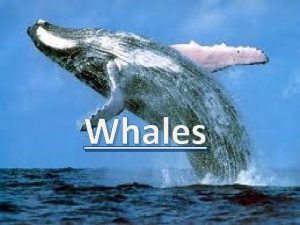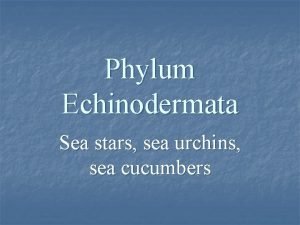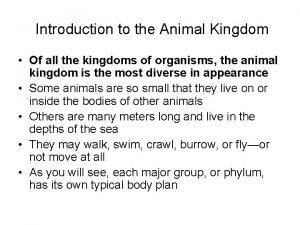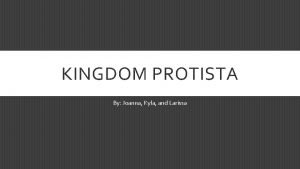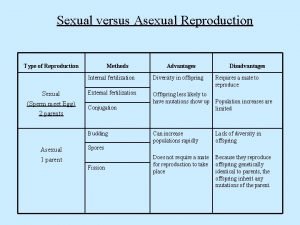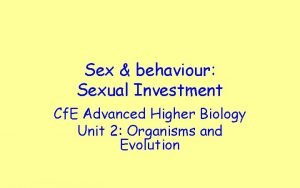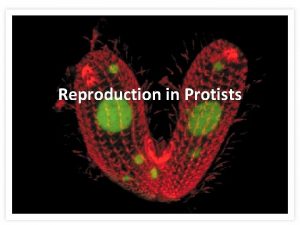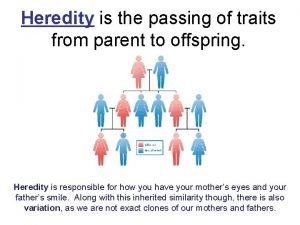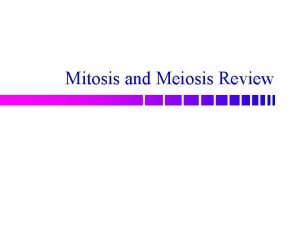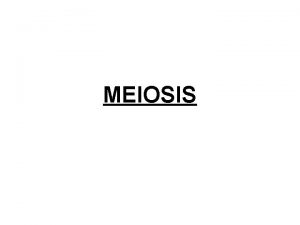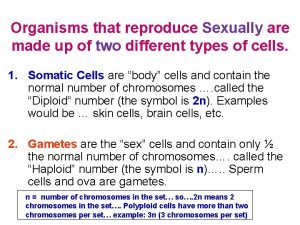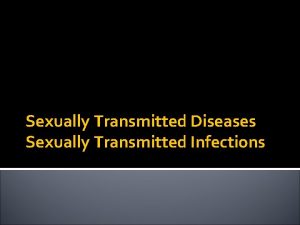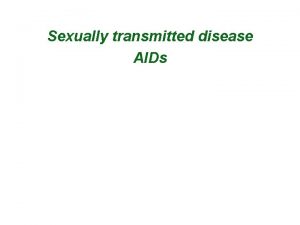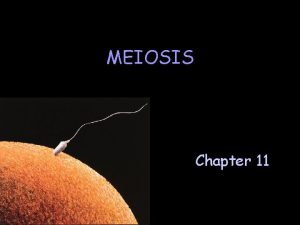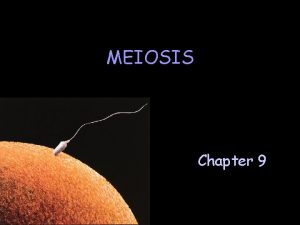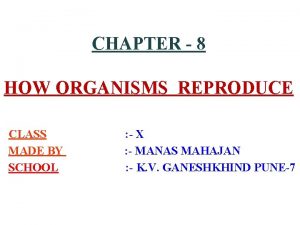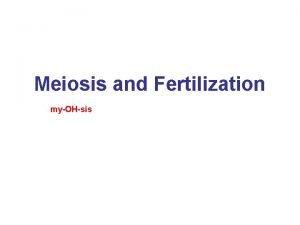MEIOSIS Organisms that reproduce Sexually are made up





























- Slides: 29

MEIOSIS

Organisms that reproduce Sexually are made up of two different types of cells. 1. Body cells contain the normal number of chromosomes 1. Examples would be … skin cells, brain cells, etc. 2. Gametes are the “sex” cells and contain only ½ the normal number of chromosomes. 1. Examples would be sperm cells and eggs are gametes.

Gametes • The Male Gamete is the Sperm • The Female Gamete is the Egg

Sperm + Egg fertilization Zygote

Homologous Chromosomes • Pair of chromosomes (maternal and paternal) paternal that are similar in shape and size. • These pairs carry genes controlling the same inherited traits. • Humans have 23 pairs of homologous chromosomes. 22 pairs of autosomes 1 pair of sex chromosomes

Sex Chromosomes The Sex Chromosomes code for the sex of the offspring. ** If the offspring has two “X” chromosomes it will be a female. ** If the offspring has one “X” chromosome and one “Y” chromosome it will be a male. In Humans the “Sex Chromosomes” are the 23 rd set XX chromosome - female XY chromosome - male

Meiosis is the process by which ”gametes” (sex cells) , with half the number of chromosomes, are produced. If Meiosis did not occur the chromosome number in each new generation would double…. The offspring would die.

Interphase I • Similar to mitosis interphase. • Chromosomes replicate (S phase). • Each duplicated chromosome consist of two identical sister chromatids.

Interphase I • Nucleus and nucleolus visible. chromatin nuclear membrane cell membrane nucleolus

Meiosis I (four phases) • Cell division that reduces the chromosome number by one-half. • four phases: phases a. prophase I b. metaphase I c. anaphase I d. telophase I

Prophase I • Longest and most complex phase. • 90% of the meiotic process is spent in Prophase I • Chromosomes condense. • Homologous chromosomes come together

Prophase I Homologous chromosomes sister chromatids Tetrad sister chromatids

During Prophase I “Crossing Over” occurs. Crossing Over is one of the Two major occurrences of Meiosis (The other is Non-disjunction) • During Crossing over segments of nonsister chromatids break and reattach to the other chromatid The Chiasmata (chiasma) are the sites of crossing over

Crossing Over creates variation (diversity) in the offspring’s traits. Tetrad nonsister chromatids chiasmata: site of crossing over variation

Question: • A cell containing 20 chromosomes at the beginning of meiosis would, at its completion, produce cells containing how many chromosomes? chromosomes

Answer: • 10 chromosomes

Prophase I spindle fiber aster fibers centrioles

Metaphase I • Shortest phase • Chromosomes align in the middle of cell

Metaphase I metaphase plate

Anaphase I • Homologous chromosomes separate and move towards the poles. • Sister chromatids remain attached at their centromeres

Anaphase I

Telophase I • Each pole now has set of chromosomes • Cytokinesis occurs and two daughter cells are formed.

Telophase I

Meiosis II • No interphase II • Remember: Meiosis II is similar to mitosis

Prophase II • same as prophase in mitosis

Metaphase II • same as metaphase in mitosis metaphase plate

Anaphase II • same as anaphase in mitosis • sister chromatids separate

Telophase II • Same as telophase in mitosis • Nuclei form. • Cytokinesis occurs.

Telophase II
 Do flatback sea turtles reproduce sexually or asexually
Do flatback sea turtles reproduce sexually or asexually How do whales reproduce sexually
How do whales reproduce sexually Urchin
Urchin Radial symmetry examples
Radial symmetry examples Worms phylum
Worms phylum Chrysophta
Chrysophta Spongocoel
Spongocoel Parasitism phylum
Parasitism phylum How do annelids reproduce
How do annelids reproduce How birds reproduce sexually
How birds reproduce sexually How protists reproduce
How protists reproduce Mikael ferm
Mikael ferm Organisms that reproduce asexually
Organisms that reproduce asexually Heredity
Heredity Meiosis has 8 main phases true or false
Meiosis has 8 main phases true or false Multicellular unicellular
Multicellular unicellular Why do organisms interact with other organisms
Why do organisms interact with other organisms Sau thất bại ở hồ điển triệt
Sau thất bại ở hồ điển triệt Thơ thất ngôn tứ tuyệt đường luật
Thơ thất ngôn tứ tuyệt đường luật Hãy nói thật ít để làm được nhiều
Hãy nói thật ít để làm được nhiều Thơ thất ngôn tứ tuyệt đường luật
Thơ thất ngôn tứ tuyệt đường luật Tôn thất thuyết là ai
Tôn thất thuyết là ai Ngoại tâm thu thất chùm đôi
Ngoại tâm thu thất chùm đôi Chiến lược kinh doanh quốc tế của walmart
Chiến lược kinh doanh quốc tế của walmart Gây tê cơ vuông thắt lưng
Gây tê cơ vuông thắt lưng Block nhĩ thất độ 2 type 1
Block nhĩ thất độ 2 type 1 Tìm độ lớn thật của tam giác abc
Tìm độ lớn thật của tam giác abc Prohase 2
Prohase 2 11/15
11/15 Chromosome disability
Chromosome disability

